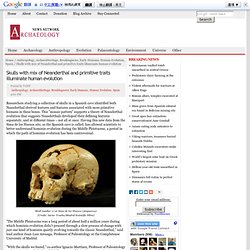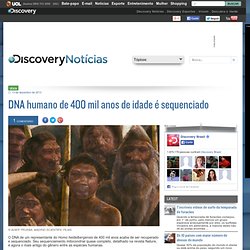

African genes tracked back. The first humans left Africa some 200,000 years ago, dispersing to populate the rest of the world.

But this was not a one-way trip: some people came back. Skulls from Spanish cave illuminate human evolution. Article created on Friday, July 11, 2014 Researchers studying a collection of skulls in a Spanish cave identified both Neanderthal-derived features and features associated with more primitive humans in these bones.

This “mosaic pattern” supports a theory of Neanderthal evolution that suggests Neanderthals developed their defining features separately, and at different times – not all at once. Having this new data from the Spanish cave site of Sima de los Huesos has allowed scientists to better understand hominin evolution during the Middle Pleistocene, a period in which the path has been controversial. Neanderthal trait found in archaic early human skull. Article created on Tuesday, July 8, 2014 Re-examination of a circa 100,000-year-old archaic early human skull found 35 years ago in Northern China has revealed the surprising presence of an inner-ear formation long thought to occur only in Neanderthals.

“The discovery places into question a whole suite of scenarios of later Pleistocene human population dispersals and interconnections based on tracing isolated anatomical or genetic features in fragmentary fossils,” said study co-author Erik Trinkaus, PhD, a physical anthropology professor at Washington University in St. Louis. Not so simple. Archaic Human Skull Discovery in China Sheds New Light on Later Human Evolution.
Surprising finding could lead to rethinking evolution of modern humans during the late Pleistocene.

Once again, scientists examining an ancient human fossil are finding that the path of human evolution, at least over the last 100,000 years, is not as simple as evolutionists have thought. In a recent study, researchers Xiu-Jie Wu, Wu Liu and Song Xing of the Institute of Vertebrate Paleontology and Paleoanthropology, Beijing, Isabelle Crevecoeur of PACEA, Université de Bordeaux, France, and Erik Trinkaus of Washington University in St.
Louis, re-examined a circa 100,000-year-old archaic human skull originally found during excavations 35 years ago at the Xujiayao site in China's Nihewan Basin. Based on their micro-CT scans of the interior configuration of the temporal bone, they found that the inner-ear formation closely resembled a formation long thought to occur only in Neanderthals. "We were completely surprised," Trinkaus said. On the go? Neandertal desapareceu devido a olhos grandes, diz estudo - BBC Brasil - Notícias. The Archaeology News Network: Skulls with mix of Neanderthal and primitive traits illuminate human evolution. Researchers studying a collection of skulls in a Spanish cave identified both Neanderthal-derived features and features associated with more primitive humans in these bones.

This "mosaic pattern" supports a theory of Neanderthal evolution that suggests Neanderthals developed their defining features separately, and at different times – not all at once. Having this new data from the Sima de los Huesos site, as the Spanish cave is called, has allowed scientists to better understand hominin evolution during the Middle Pleistocene, a period in which the path of hominin evolution has been controversial. "The Middle Pleistocene was a long period of about half a million years during which hominin evolution didn't proceed through a slow process of change with just one kind of hominin quietly evolving towards the classic Neanderthal," said lead author Juan-Luis Arsuaga, Professor of Paleontology at the Complutense University of Madrid.
Arsuaga and his team were delighted to work on this effort. Talking Neanderthals challenge the origins of speech. We humans like to think of ourselves as unique for many reasons, not least of which being our ability to communicate with words.

But ground-breaking research by an expert from the University of New England shows that our ‘misunderstood cousins,’ the Neanderthals, may well have spoken in languages not dissimilar to the ones we use today. Pinpointing the origin and evolution of speech and human language is one of the longest running and most hotly debated topics in the scientific world. It has long been believed that other beings, including the Neanderthals with whom our ancestors shared the Earth for thousands of years, simply lacked the necessary cognitive capacity and vocal hardware for speech. “To many, the Neanderthal hyoid discovered was surprising because its shape was very different to that of our closest living relatives, the chimpanzee and the bonobo.
Archaeology News and Archeology Magazine - HeritageDaily. Ancient viruses from Neanderthals have been found in modern human DNA by researchers at Oxford University and Plymouth University. The researchers compared genetic data from fossils of Neanderthals and another group of ancient human ancestors called Denisovans to data from modern-day cancer patients. They found evidence of Neanderthal and Denisovan viruses in the modern human DNA, suggesting that the viruses originated in our common ancestors more than half a million years ago.
This latest finding, reported in Current Biology, will enable scientists to further investigate possible links between ancient viruses and modern diseases including HIV and cancer, and was supported by the Wellcome Trust and Medical Research Council (MRC). The First Americans. In the 1970s, college students in archaeology such as myself learned that the first human beings to arrive in North America had come over a land bridge from Asia and Siberia approximately 13,000 to 13,500 years ago.

These people, the first North Americans, were known collectively as Clovis people. Their journey was made possible, according to archaeologists far and wide, by a corridor that had opened up between giant ice sheets covering what is now Alaska and Alberta. Thus did the Clovis people move down through the North American continent, carrying their distinctive tools to various sites in the Plains States and the Southwest and then moving eastward. And all of this they did very quickly. Theory About Human Evolution. Timeline of human origins revised. Article created on Thursday, July 3, 2014 Many traits unique to humans were long thought to have originated in the genus Homo between 2.4 and 1.8 million years ago in Africa.

Although scientists have recognized these characteristics for decades, they are reconsidering the true evolutionary factors that drove them. A large brain, long legs, the ability to craft tools and prolonged maturation periods were all thought to have evolved together at the start of the Homo lineage as African grasslands expanded and Earth’s climate became cooler and drier. DNA humano de 400 mil anos de idade é sequenciado. O DNA de um representante do Homo heidelbergensis de 400 mil anos acaba de ser recuperado e sequenciado.

Osso revela que neandertais falavam como o homem moderno. Mungo Man: The Story Behind The Bones That Forever Changed Australia’s History. This is a story about bones.

About what can and can’t be explained by them, and the tales we choose for them to tell. It spans more than 50,000 years, but it begins like it ends, in a remote corner of the red-rubbled Australian Outback some 700 kilometers (435 miles) west of Sydney known as Lake Mungo. Lake Mungo isn’t actually a lake -- at least not anymore. But up until about 20,000 years ago, this lunar-like landscape of silver-blue saltbush and antagonistic flies was a lush lagoon teeming with fish and waterbirds. It was an Aboriginal paradise with easy hunting and abundant resources. Earliest human footprints outside Africa found – in Norfolk. Feb 07, 2014 News, Slider 1 These footprint hollows, shown in situ on the beach at Happisburgh, Norfolk, are the oldest human footprints known from outside Africa.Photo: Martin Bates Archaeologists have found the earliest human footprints known outside Africa, at Happisburgh on the Norfolk coast.
D4500 & D2600, A Complete Skull from Dmanisi, Georgia. Ramidus Returns. Oldest Hominin Footprints Found Outside of Africa. The Laetoli hominin footprints have finally met their match. A group of footprints dating between 850,000 and 950,000 years ago were reported in coastal Happisburgh, the United Kingdom, as seen in a publication in Plos One today. The work was headed by Nick Ashton of the British Museum. Laetoli Footprints, Tanzania. Photo by Tim Evanson Footprints are rarely preserved prehistorically—their survival generaly requires just the right level of moisture and sediment composition, followed by a low-energy depositional context to gently cover the impression. The reported age of the geological layers exceeds the date of the oldest site in the region by 350,000 years, pushing back known human occupation in Northern Europe significantly. Happisburgh hominin footprints, from Ashton et al. 2013. The researchers approximated the height of individuals in the group to be just below one meter, to 1.73 meters tall based on foot size to stature ratios.
Matthew Magnani Like this: Like Loading... A New Twist in the Neandertal Lineage. Just in from Atapuerca, northern Spain: mitochondrial DNA has been retrieved from the bones of Homo heidelbergensis. The Sima de los Huesos, or pit of bones, has been a treasure trove of human remains, and has yielded a minimum number of 28 individuals dating to at least 300,000 years ago. This type of preservation and concentration of human remains is rare—most excavations are lucky to turn up a stray hominin tooth every couple of seasons. Homo heidelbergensis cranium number five from the Sima. Modern Human faces Neanderthal across the Danube. Dipl.Geol.Univ. Alexander Binsteiner examined in his thesis the chert deposit of Baierdorf at Ried castle in Altmühltal. After that, he was a field director of excavations at the flint mine of Arnhofen near Abensberg.
From 1993-96 he was chief geologist of the Ötzi Project at the University of Innsbruck. Today he divides his time as a freelance geoarchaeologist between Austria, Bavaria and the Czech Republic. Neandertais foram quase extintos antes do surgimento dos humanos. Esqueleto e modelo restaurado de um neandertal, em exposição no Museu Nacional de Ciências Naturais, Tóquio, Japão. Os neandertais da Europa ocidental podem ter sofrido uma crise populacional durante um período de frio intenso, sugere um novo sequenciamento de DNA mitocondrial. “Foi uma surpresa descobrir que os neandertais dessa região foram quase extintos, mas se recuperaram bem antes de entrar em contato com os humanos modernos”, conta o co-autor da pesquisa, Love Dalén, professor-associado do Museu Sueco de História Natural, em entrevista ao Phys.org. ”Isso indica que os neandertais eram mais sensíveis às mudanças climáticas drásticas que ocorreram na última era glacial do que imaginávamos”.